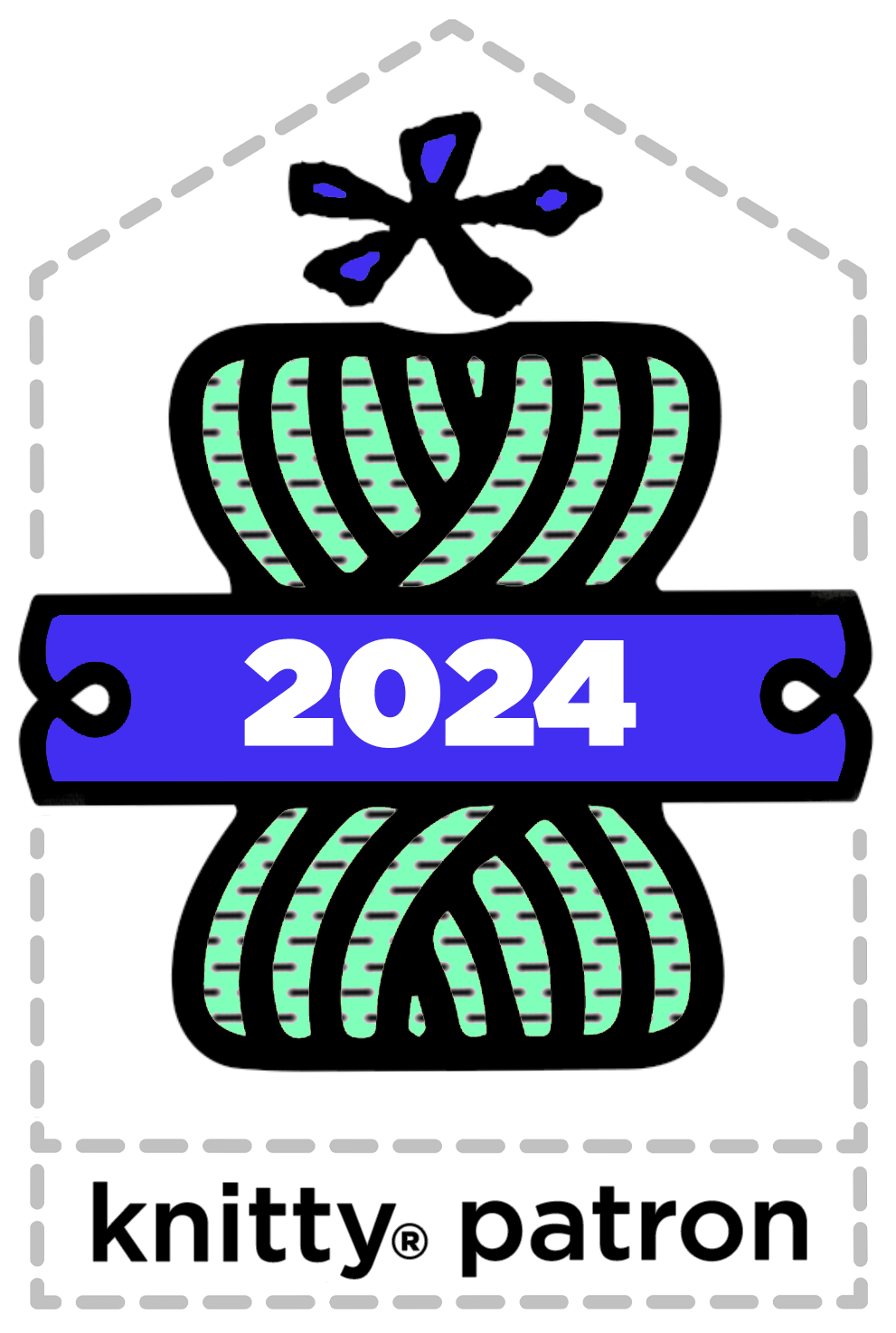River Severn, a free knitting pattern from Knitty.com.
INTRODUCTION
River Severn
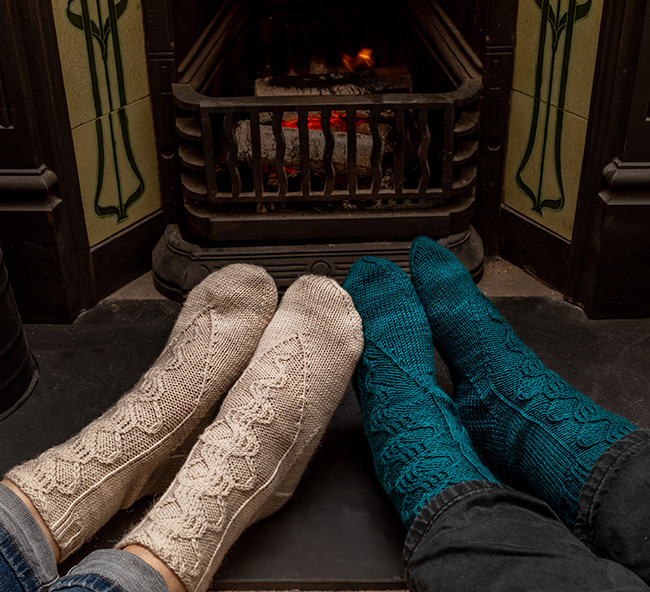 by Brenda Dayne and Jeny Staiman
by Brenda Dayne and Jeny Staiman
![]()
High in the Cambrian mountains of mid-Wales lies the source of three rivers, known in legend as the Three Sisters. As the story is told, spirits of the rivers Ystwth, Wye and Severn met on the slopes of Mount Plynlimon to discuss the best way to reach the Celtic sea, for all desired to meet its great waters.
Ystwyth, the first of the sisters and the most impatient, decided that she would flow west in the shortest and most direct path, and she reached the sea long before her sisters.
The second sister, Wye, was a little less hasty. She decided to enjoy her journey and chose a wandering path through the ancient forests between England and Wales. She came second in the sisters' race to the sea.
Severn, the third sister, had no desire to rush her journey. She moved very slowly, taking in the natural wonders around her, and visiting the great cities of men. Hers was the longest journey of the three sisters, and this is how the River Severn became the longest river in Britain.
Like the River Severn, crossed and twisted stitches meander from the cuff of this sock, taking their time before reaching their final destination near the toe. The stitches have such a lovely rhythm to them and are so much fun to work, you'll want to take your time and enjoy the journey. We offer instructions for both fingering and sport weight yarn.
River Severn construction is mostly classic cuff down, but we have hybridized several of the elements to make the sock a faster and tidier knit. The 1/1 crosses are worked in two swift motions and slipped off the needle together, rather than moving stitches around before working them. The heel is a slightly rounded square heel, which conforms better to the foot than either a round or square heel.
 photos: Sport weight – Mat Webb, Fingering weight – Jeff Staiman
photos: Sport weight – Mat Webb, Fingering weight – Jeff Staiman
SIZE
Adult XS[S, M, L]
FINISHED MEASUREMENTS
Foot Circumference: 7[8, 9, 10] inches/ 18[20.5, 23, 25.5] cm
Foot Length: Adjustable to fit
Leg Length: 5.5 inches/14 cm (adjustable)
Choose a size approximately 0.5-1 inch/1-2.5 cm smaller than actual foot circumference.
MATERIALS
Yarn
![]() Fingering weight (shown below): Miss Babs Tarte Fingering [75% Superwash Merino, 15% Nylon, 10% Tencel; 500 yd/457 m per 4.3 oz/122 g skein]; Color: Corset
Fingering weight (shown below): Miss Babs Tarte Fingering [75% Superwash Merino, 15% Nylon, 10% Tencel; 500 yd/457 m per 4.3 oz/122 g skein]; Color: Corset
Yarn Characteristics
![]() Choose a plied yarn in a solid or near-solid colorway with a tight twist to ensure the socks are hardwearing.
Choose a plied yarn in a solid or near-solid colorway with a tight twist to ensure the socks are hardwearing.
Recommended needle size
[always use a needle size that gives you the gauge listed below - every knitter's gauge is unique]
![]() Fingering weight: US #1/2.25 mm needles for small circumference in the round
Fingering weight: US #1/2.25 mm needles for small circumference in the round
![]() Sport weight: US #3/3.25 mm needles for small circumference in the round
Sport weight: US #3/3.25 mm needles for small circumference in the round
Notions
![]() stitch markers (optional)
stitch markers (optional)
![]() yarn needle
yarn needle
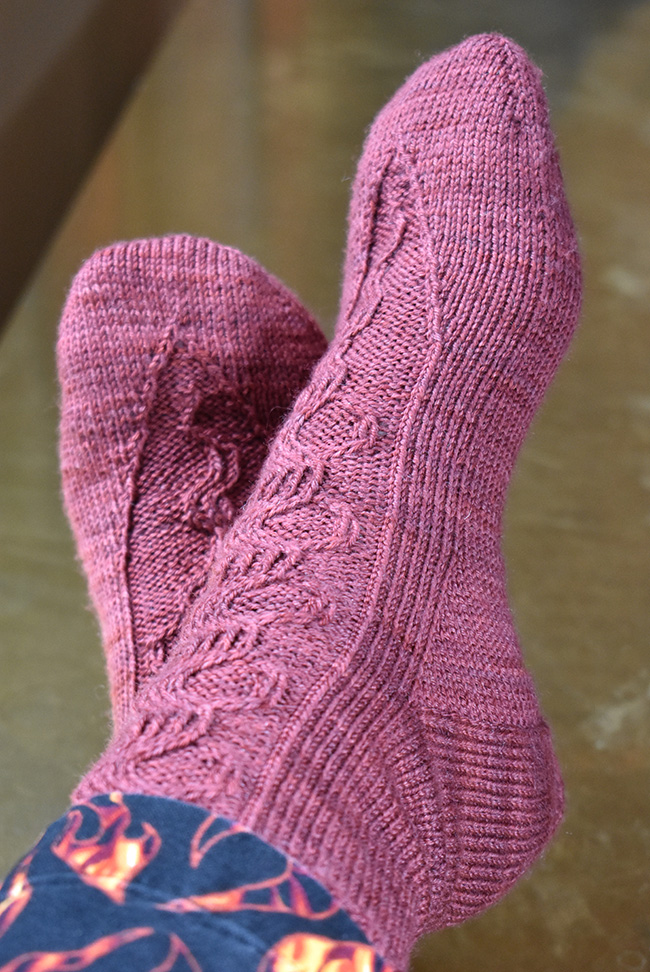
GAUGE
Fingering weight: 32 sts x 44 rounds = 4 inches/10cm in stockinette stitch.
Sport weight: 24 sts x 36 rounds = 4 inches/10cm in stockinette stitch.
PATTERN NOTES
[Knitty's list of standard abbreviations and techniques can be found here.]
Important Note: In the instructions below, where steps are different for the two different weights of yarn, they are separated. In some cases, the instructions are the same except for stitch counts, etc. In that case, the numbers are divided by this symbol ^ in the following format: fingering ^ sport
Techniques:
The 1/1 knit crosses in this pattern are worked a little differently than the traditional method. Rather than using a cable needle to re-order the stitches before working them, they are knitted in opposite order and then slipped off simultaneously. This method lets the crosses lie flatter, draws the fabric in less, and can be worked more quickly.
1/1 RC: K second st, k first st, slip both sts off needle.
1/1 LC: K second st tbl from behind, k first st, slip both sts off needle.
Toes Without Ears
Use this modification from Modern Daily Knitting.
CHARTS
River Chart pattern contains two groups of twisted stitches: a foreground pattern which is constant, and a background pattern which twines behind the foreground pattern. Stream chart tapers the foreground pattern down to a trickle.
Note: Work one sock using the Right Charts, work the second using the Left charts.
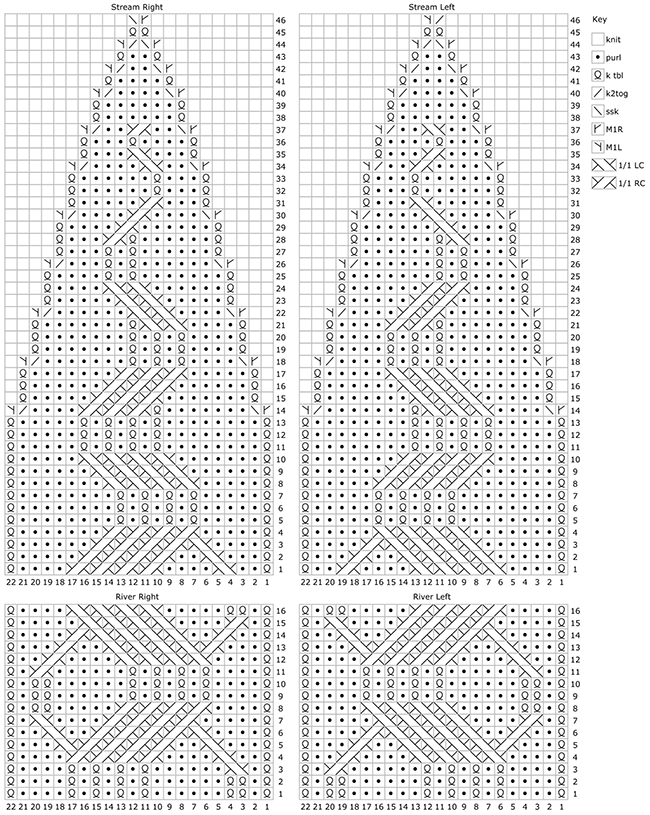
DIRECTIONS

Important Note: In the instructions below, where steps are different for the two different weights of yarn, they are separated. In some cases, the instructions are the same except for stitch counts, etc. In that case, the numbers are divided by this symbol ^ in the following format: fingering ^ sport
Leg
Using your preferred stretchy method, CO 56[64, 72, 80] ^ 44[50, 56, 62] sts.
Distribute sts across needles as you prefer, and join for working in the round.
Ribbing Rnd 1, Fingering: Work Round 1 of appropriate River chart; (k2 tbl, p2) to last 2 sts, k2 tbl.
Ribbing Rnd 1, Sport:
Sizes XS and M only: Work Round 1 of appropriate River chart; (k2 tbl, p2) to last 2 sts, k2 tbl.
Sizes S and L only: Work Round 1 of appropriate River chart; k1 tbl, (p2, k2 tbl) to last 3 sts, p2, k1 tbl.
Ribbing Rnd 2, both yarn weights: Work River chart as set over 22 sts; work ribbing in pattern to end of round.
Continue working ribbing to desired length (3 inches of ribbing shown on Corset fingering weight socks, 1 inch of ribbing shown on White Peppercorn sport weight socks) as you continue working the River chart. When you have reached the desired length of ribbing, switch to stockinette as follows:
Leg round, both yarn weights: Work River chart as set over 22 sts, k to end of round.
Continue until you have worked all 16 rounds of River chart a total of 4 ^ 3 times, then work Rounds 1–2 of the chart once more.
Note: For longer or shorter socks you may repeat the River chart as many times as desired.
Heel Flap
To setup for heel: Work Round 3 of River chart, k 3[5, 7, 9] ^ k 0[2, 3, 5] , stop.
This is the new start of round position for working the heel.
Heel flap is worked back and forth in stockinette rows over the next 28[32, 36, 40] ^ 22[24, 28, 30] , sts, and the remaining 28[32, 36, 40] ^ 22[26, 28, 32] sts are held for the instep. Rearrange and place instep sts on a holder or separate needle to keep them out of your way as you work the flap.
Row 1 [RS]: K 28[32, 36, 40] ^ 22[24, 28, 30] . Turn.
Row 2 [WS]: Sl 1 pwise wyif, p to end. Turn.
Row 3 [RS]: Sl 1 pwise wyib, k to end. Turn.
Repeat Rows 2–3 15[17, 19, 21] ^ 11[12, 14, 16] more times, then work Row 2 once more.
Heel Turn
Row 1 [RS]: Sl 1, k 18[20, 22, 24] ^ 14[15, 17, 18] ssk, k1, turn.
Row 2 [WS]: Sl 1, p9 ^ 7, p2tog, p1, turn.
Row 3 [RS]: Sl 1, k to 1 stitch before gap, ssk, k1, turn.
Row 4 [WS]: Sl 1, p to 1 stitch before gap, p2tog, p1, turn.
Fingering weight:
Size XS, proceed to All sizes, below.
Sizes S, M and L, repeat Rows 3–4 –[1, 2, 3] more times.
Sport weight:
Sizes XS and S, proceed to All Sizes. Sizes M and L, repeat Rows 3–4 once more.
All sizes and both yarn weights, continue:
Next row [RS]: Sl 1, k 12[14, 16, 18] ^ 10[10, 12, 12] (1 st before gap), ssk, turn.
Next row [WS]: Sl 1, p 12[14, 16, 18] ^ 10[10, 12, 12] (1 st before gap), p2tog, turn. 4 ^ 2[3, 3, 4] sts opposite each gap.
Repeat last two rows 4 ^ 2[3, 3, 4] more times until all sts have been worked. 14[16, 18, 20] ^ 12[12, 14, 14] sts rem.
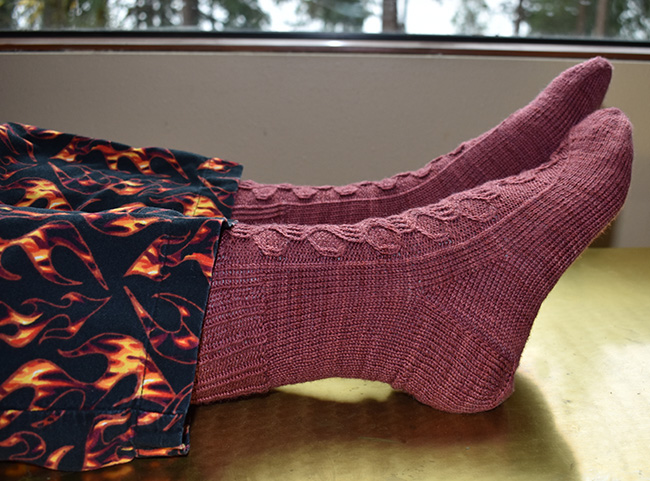
Gusset
Round 1, Fingering only: K 14[16, 18, 20] heel sts, pick up and knit 17[19, 21, 23] sts along the edge of the heel flap, which includes a stitch in the round just below the first flap row; work across motif area, following Round 4 of River chart. Pick up and knit 17[19, 21, 23] sts along second edge of heel flap as you did for the first. This is the start of the round. The instep has 28[32, 36, 40] sts, with the 22-stitch motif centered in it. Rearrange sts or place markers as you prefer. 76[86, 96, 106] sts total.
Round 1, Sport only: K 12[12, 14, 14] heel sts, pick up and knit 13[14, 16, 18] sts along the edge of the heel flap, which includes a stitch in the round just below the first flap row; work across motif area, following Round 1 of Stream chart. Pick up and knit 13[14, 16, 18] sts along second edge of heel flap as you did for the first. This is the start of the round. The instep has 22[26, 28, 30] sts, with the 22-stitch motif centered in it. Rearrange sts or place markers as you prefer. 60[66, 74, 82] sts total.
Round 2, both yarn weights: Work across instep in pattern as set; k1, ssk, k to last 2 sts, k2tog, k1. 2 sts decreased on sole.
Round 3: Work in pattern as set.
Repeat Rounds 2–3, 9[10, 11, 12] ^ 7[7, 8, 8] more times, switching to Round 1 of Stream chart for fingering sock after you have completed one more River repeat ending with Round 3. 56[64, 72, 80] ^ 44[50, 56, 62] sts total.
Note: For feet measuring 10.5 inches/26.5 cm or longer, two River repeats can be worked through the instep before switching to Stream.
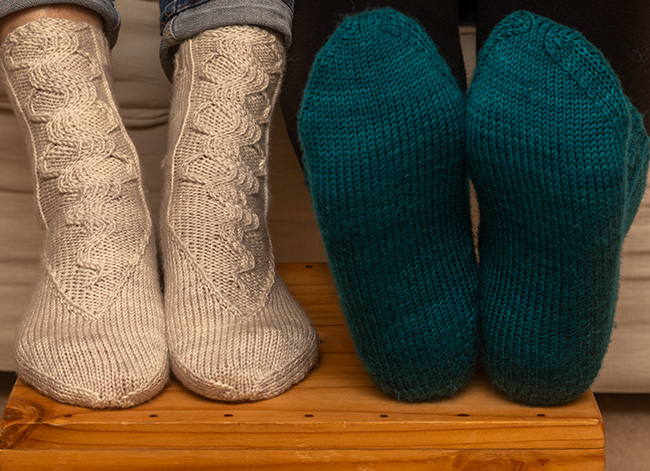
Foot
Continue as established in pattern, transitioning to stockinette stitch after round 46 of Stream chart. Work until sock measures approximately [1.25 inches/ 3 cm] | [1 inch/2.5 cm] short of desired finished length.
For Sport sizes S and L ONLY: knit 1 more stitch. This is the new start of the round.
Toe
Prior to working the toe, use markers or rearrange your stitches to group them so that you have 28[32, 36, 40] ^ 22[24, 28, 30] sts for the instep, and 28[32, 36, 40] ^ 22[26, 28, 32] sts for the sole.
Sport only:
Round 1: K1, ssk, k to last 3 sts of instep, k2tog, k2, ssk, k to last 3 sts, k2tog, k1. 4 sts decreased.
Round 2: Knit.
Repeat Rounds 1-2 twice more. 32[38, 44, 50] sts
Repeat Round 1 4 more times. 16[22, 28, 34] sts.
Sizes S and L only: K across instep, k1, ssk, k to last 3 sts, k2tog, k1. –[20, –, 32] sts.
Fingering only:
Round 1: K1, ssk, k to last 3 sts of instep, k2tog, k2, ssk, k to last 3 sts, k2tog, k1. 4 sts decreased.
Round 2: Knit.
Repeat Rounds 1-2 3 more times. 40[48, 56, 64] sts.
Repeat Round 1 6 more times. 16[24, 32, 40] sts.
All sizes and weights: Cut yarn and graft sides together traditionally, or use the modification listed in the pattern notes that eliminates the “ears” commonly visible on the sides of toes worked with a traditional graft.
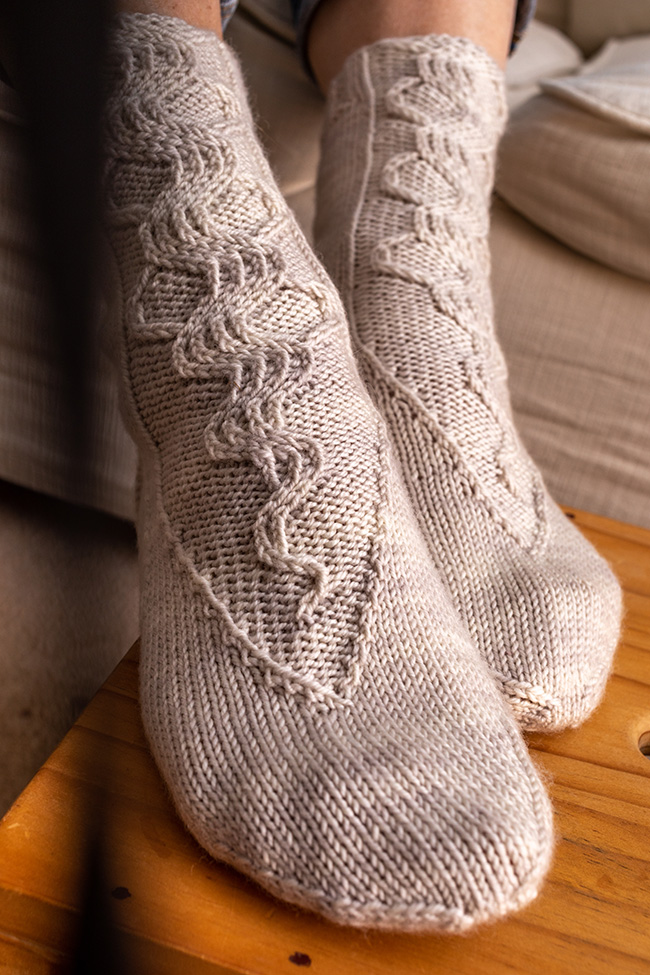
FINISHING
Wash and lay flat to dry. Weave in ends.
ABOUT THE DESIGNER
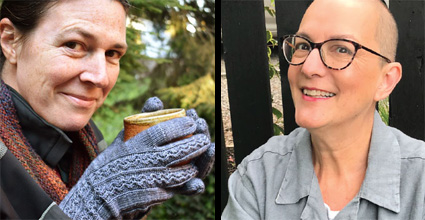 Jeny (left) lives just outside Seattle, WA. When she's not designing knitwear (Ravelry link) she's working with dogs, hiking in the Cascades, or hanging out with her family.
Jeny (left) lives just outside Seattle, WA. When she's not designing knitwear (Ravelry link) she's working with dogs, hiking in the Cascades, or hanging out with her family.
Brenda (right) lives in Pembrokeshire, Wales. When she's not designing knitwear (Ravelry link) she's talking into a microphone about her knitting, sewing and her ongoing quest to create a capsule wardrobe, in her podcast, Cast On.
Brenda and Jeny met around 10 years ago through Cat Bordhi's Visionary group. Their friendship has meandered through its own twists and turns just like the River Severn, as they each took time away from knit design to do other things like hiking in the wilderness or going to graduate school, before returning to this shared interest. Their long-distance collaboration on this design was a spontaneous idea, and incredibly fun!
Pattern & images © 2021 Brenda Dayne and Jeny Staiman







